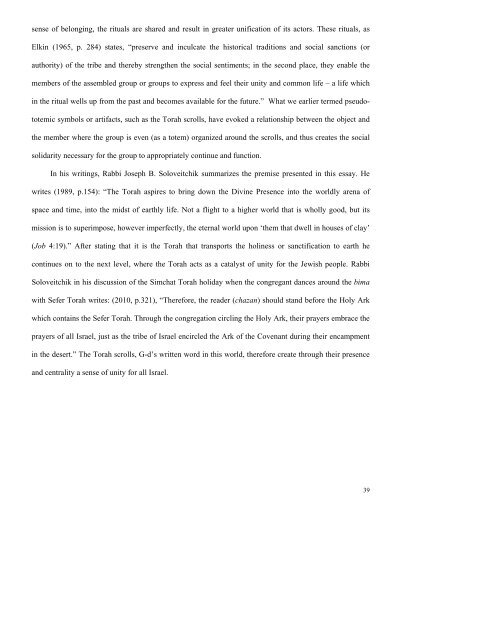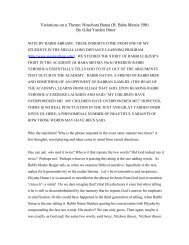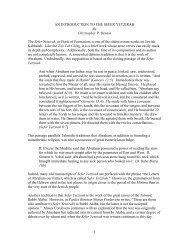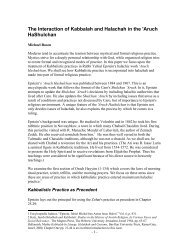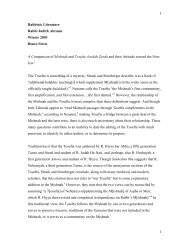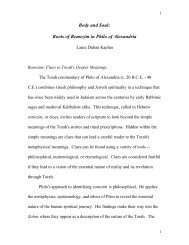The Symbolic Representation of the Sefer Torah - Maqom
The Symbolic Representation of the Sefer Torah - Maqom
The Symbolic Representation of the Sefer Torah - Maqom
You also want an ePaper? Increase the reach of your titles
YUMPU automatically turns print PDFs into web optimized ePapers that Google loves.
sense <strong>of</strong> belonging, <strong>the</strong> rituals are shared and result in greater unification <strong>of</strong> its actors. <strong>The</strong>se rituals, asElkin (1965, p. 284) states, “preserve and inculcate <strong>the</strong> historical traditions and social sanctions (orauthority) <strong>of</strong> <strong>the</strong> tribe and <strong>the</strong>reby streng<strong>the</strong>n <strong>the</strong> social sentiments; in <strong>the</strong> second place, <strong>the</strong>y enable <strong>the</strong>members <strong>of</strong> <strong>the</strong> assembled group or groups to express and feel <strong>the</strong>ir unity and common life – a life whichin <strong>the</strong> ritual wells up from <strong>the</strong> past and becomes available for <strong>the</strong> future.” What we earlier termed pseudototemicsymbols or artifacts, such as <strong>the</strong> <strong>Torah</strong> scrolls, have evoked a relationship between <strong>the</strong> object and<strong>the</strong> member where <strong>the</strong> group is even (as a totem) organized around <strong>the</strong> scrolls, and thus creates <strong>the</strong> socialsolidarity necessary for <strong>the</strong> group to appropriately continue and function.In his writings, Rabbi Joseph B. Soloveitchik summarizes <strong>the</strong> premise presented in this essay. Hewrites (1989, p.154): “<strong>The</strong> <strong>Torah</strong> aspires to bring down <strong>the</strong> Divine Presence into <strong>the</strong> worldly arena <strong>of</strong>space and time, into <strong>the</strong> midst <strong>of</strong> earthly life. Not a flight to a higher world that is wholly good, but itsmission is to superimpose, however imperfectly, <strong>the</strong> eternal world upon ‘<strong>the</strong>m that dwell in houses <strong>of</strong> clay’(Job 4:19).” After stating that it is <strong>the</strong> <strong>Torah</strong> that transports <strong>the</strong> holiness or sanctification to earth hecontinues on to <strong>the</strong> next level, where <strong>the</strong> <strong>Torah</strong> acts as a catalyst <strong>of</strong> unity for <strong>the</strong> Jewish people. RabbiSoloveitchik in his discussion <strong>of</strong> <strong>the</strong> Simchat <strong>Torah</strong> holiday when <strong>the</strong> congregant dances around <strong>the</strong> bimawith <strong>Sefer</strong> <strong>Torah</strong> writes: (2010, p.321), “<strong>The</strong>refore, <strong>the</strong> reader (chazan) should stand before <strong>the</strong> Holy Arkwhich contains <strong>the</strong> <strong>Sefer</strong> <strong>Torah</strong>. Through <strong>the</strong> congregation circling <strong>the</strong> Holy Ark, <strong>the</strong>ir prayers embrace <strong>the</strong>prayers <strong>of</strong> all Israel, just as <strong>the</strong> tribe <strong>of</strong> Israel encircled <strong>the</strong> Ark <strong>of</strong> <strong>the</strong> Covenant during <strong>the</strong>ir encampmentin <strong>the</strong> desert.” <strong>The</strong> <strong>Torah</strong> scrolls, G-d’s written word in this world, <strong>the</strong>refore create through <strong>the</strong>ir presenceand centrality a sense <strong>of</strong> unity for all Israel.39


